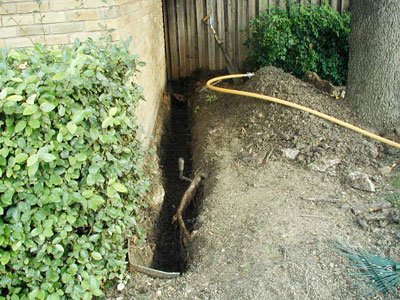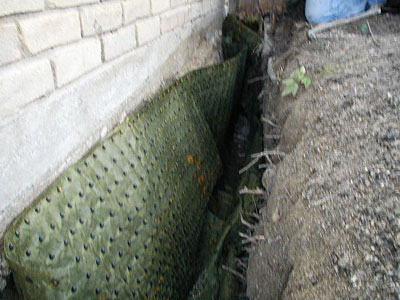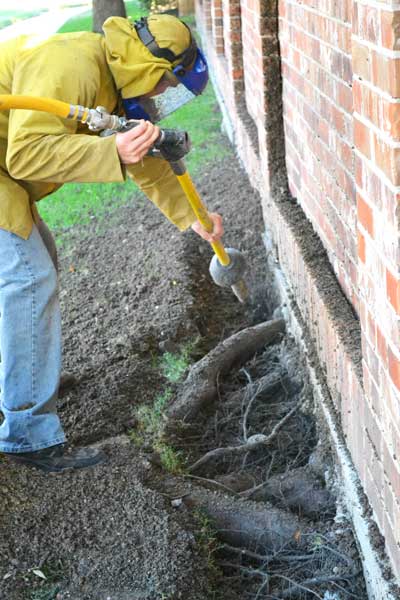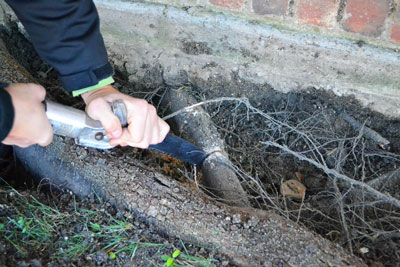Texas Tree Tips: March 2015

Pneumatic air tools can be used to dig trenches without damaging tree roots that might be in or near the excavation area.
By Steve Houser
Root Barriers
The moisture content of the soil under your foundation, driveway, or walkway will constantly change with the weather throughout the year. As a result, the soil can shrink or swell in size or in volume. As this occurs, cracking or movement of the concrete often takes place. And guess what gets blamed? Of course, it is your favorite tree!
It’s a classic case of, “That tree needs to go to save my foundation, driveway, or other structures. How dare that tree. It’s actually trying to grow, and it takes all the moisture from under my foundation. I love trees as much as the next guy, but….” Trees and arborists shudder when they hear this phrase because they know what is coming next.
Trees do remove water from the soil, but if you keep them watered, trees have no negative effect on structures unless there is physical contact. As roots and trunk expand in diameter each year, they can add pressure to hardscape features and structures.
This physical pressure can be alleviated only by removing the structure, the entire tree, or some of the offending roots. If a larger tree near a structure is removed or if larger roots are cut, problems can arise as the detached roots rot and decay, leaving holes in the soil that can lead to foundation or structural problems.

Once the excavation is complete, conflicting tree roots, irrigation pipes, and other underground utilities and structures are exposed.
For small or medium-sized trees that are about 10 to 15 feet from a structure, roots can be cut and a root barrier installed to help reduce root system infringement. However, research shows that root barriers are only a short-term solution, since roots will eventually grow under or over the root barrier, given time. Tree roots are very persistent in seeking soil elements, even that found in your sewer lines. Folks may be feeding a tree but don`t know it — until a sewer line is clogged.

Once conflicting items are addressed, root barriers or bio-fabric can easily be set in place.
A consulting arborist must carefully consider the pros and cons of using a root barrier, since cutting too many roots can cause the loss of the tree and negatively affect the structural support offered by the root system. The species of tree, its size, and its health, as well as its proximity to a structure, must be taken into account in determining the effectiveness of a root barrier.

Pneumatic air tools are commonly used to locate roots and determine if a conflict between tree roots and hardscapes or structures exist.
Although traditional trenching machines can be used to cut roots, they often leave roots torn, ripped, and open to decay-causing fungi. A better approach is to excavate with a pneumatic air tool. It can remove soil without damaging the root system and will allow for clean cuts to be made on the ends of the remaining roots. Plastic sheets, corrugated fiberglass, and fabric are often used as a physical barrier installed in the trench and buried. The depth of the barrier should be at least 3 to 5 feet deep, but roots will eventually grow under it unless it is installed on top of solid rock. Even then, roots may still find a way under the barrier. Roots are like tree huggers; they tend to be persistent little buggers.

Once exposed, large conflicting roots can be severed using traditional pruning tools. Clean cuts promote healing and reduce the likelihood of decay.
When roots must be cut, fall or winter is the best time of year. Avoid thinning the foliage as this can decrease root growth and regeneration. Consider fertilizing your tree to help offset root loss and to let your favorite tree know that you are sorry for cutting its roots. A little hug also helps if you know the proper method.

The proper method of hugging a tree involves pressing as much of your body against the tree as possible. It also helps if you are barefoot!!

